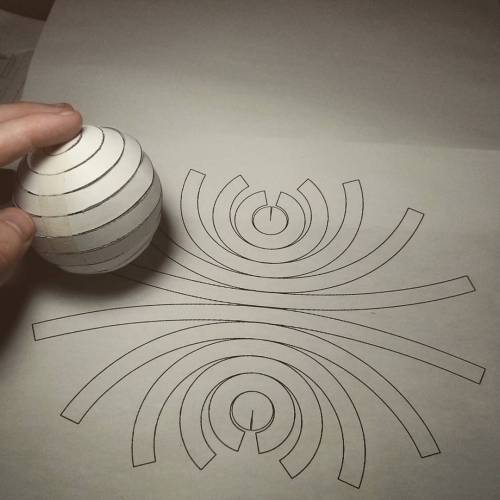Sleepysneezeydopeydoc-blog - Physics Nerd

More Posts from Sleepysneezeydopeydoc-blog and Others

Venus over Bioluminescent Algae

🐧

😊


Can you flatten a sphere?
The answer is NO, you can not. This is why all map projections are innacurate and distorted, requiring some form of compromise between how accurate the angles, distances and areas in a globe are represented.
This is all due to Gauss’s Theorema Egregium, which dictates that you can only bend surfaces without distortion/stretching if you don’t change their Gaussian curvature.
The Gaussian curvature is an intrinsic and important property of a surface. Planes, cylinders and cones all have zero Gaussian curvature, and this is why you can make a tube or a party hat out of a flat piece of paper. A sphere has a positive Gaussian curvature, and a saddle shape has a negative one, so you cannot make those starting out with something flat.
If you like pizza then you are probably intimately familiar with this theorem. That universal trick of bending a pizza slice so it stiffens up is a direct result of the theorem, as the bend forces the other direction to stay flat as to maintain zero Gaussian curvature on the slice. Here’s a Numberphile video explaining it in more detail.
However, there are several ways to approximate a sphere as a collection of shapes you can flatten. For instance, you can project the surface of the sphere onto an icosahedron, a solid with 20 equal triangular faces, giving you what it is called the Dymaxion projection.
The Dymaxion map projection.
The problem with this technique is that you still have a sphere approximated by flat shapes, and not curved ones.
One of the earliest proofs of the surface area of the sphere (4πr2) came from the great Greek mathematician Archimedes. He realized that he could approximate the surface of the sphere arbitrarily close by stacks of truncated cones. The animation below shows this construction.
The great thing about cones is that not only they are curved surfaces, they also have zero curvature! This means we can flatten each of those conical strips onto a flat sheet of paper, which will then be a good approximation of a sphere.
So what does this flattened sphere approximated by conical strips look like? Check the image below.
But this is not the only way to distribute the strips. We could also align them by a corner, like this:
All of this is not exactly new, of course, but I never saw anyone assembling one of these. I wanted to try it out with paper, and that photo above is the result.
It’s really hard to put together and it doesn’t hold itself up too well, but it’s a nice little reminder that math works after all!
Here’s the PDF to print it out, if you want to try it yourself. Send me a picture if you do!
A particle here can affect one on the other side of the universe, instantaneously
When an electron meets its antimatter twin, a positron, the two are annihilated in a tiny flash of energy. Two photons fly away from the blast.
Subatomic particles like photons and quarks have a quality known as “spin”. It’s not that they’re really spinning – it’s not clear that would even mean anything at that level – but they behave as if they do. When two are created simultaneously the direction of their spin has to cancel each other out: one doing the opposite of the other.
Due to the unpredictability of quantum behaviour, it is impossible to say in advance which will go “anticlockwise” and the other “clockwise”. More than that, until the spin of one is observed, they are both doing both.
It gets weirder, however. When you do observe one, it will suddenly be going clockwise or anticlockwise. And whichever way it is going, its twin will start spinning the other way, instantly, even if it is on the other side of the universe. This has actually been shown to happen in experiment (albeit on the other side of a laboratory, not a universe).


Dark Energy
Dark energy is in physical cosmology and astrology as an unknown form of energy that permeates through space making up for 68.3% of the observable universe (dark matter takes up 26.8%, only 4.9% is ordinary matter). Dark energy is currently the most accepted hypothesis to explain why the universe is expanding at an accelerated rate (if the observable universe comprised of only the ordinary matter we see, the universe would be expanding at a much slower rate than it currently is thus meaning dark matter and dark energy make up the mass for the accelerated rate of expansion). On a mass–energy equivalence basis, the density of dark energy (6.91 × 10^−27 kg/m3) is very low, much less than the density of ordinary matter or dark matter within galaxies.
Dark energy is not known to react with any of the fundamental forces other than gravity. It clearly has a large impact on the universe making up for 68.3% of universal density, only because it fills an otherwise empty space. The two current leading models are a cosmological constant and quintessence. Both models conclude that dark energy must have a negative pressure.
The effect of dark energy: a small constant negative pressure of vacuum

Yeah! Why not? 🐓

The five ingredients of a particle accelerator
Did you know there are over 30,000 particle accelerators in the world? The design of particle accelerators is a creative process. Often it starts with just one person and their concept, but they all tend to have 5 key ingredients.
1 - Particles - where do you get them, how do you make them? Accelerators might use atoms with electrons split off, called ions, or the particles inside atoms themselves: electrons or protons.

2 - Energy - you need an acceleration mechanism, some way of giving the particles a push. Typically this uses electric fields.

3 - Control - once your particles are moving, you need to control them, to move them and focus them where they’re needed. This is generally done with magnetic fields.

4 - Collision - not all particle accelerators are ‘colliders’ in the traditional sense. They don’t all collide beams together like at the LHC. But in almost every case you do need to collide your beam of accelerated particles into something - this might be a fixed target to investigate a sample, or even directly into a person’s body, such as during medical treatments.

5 - Detection - there’s normally not much point doing all of this work unless you can then detect the outcome and learn from it. You need to measure what happens to the beam of particles when they collide with their target.

Find out more in our animation about how to design a particle accelerator.
Spontaneous symmetry breaking

A good way to get an idea of what this is like is through water. Water has four different forms it could take depending on the conditions; frost, snow, ice and rime. Spontaneous symmetry breaking is sort of like this.
At the start of the big bang there was a single force which started off hot and as it expanded began to cool and in 1x10-46s (supposed to be scientific notation) gravity came into existence.
Now there is gravity and the force energy of the universe. This force energy then split into the strong nuclear force (SNF) at about 1x10-36s.
Then shorty after the massive inflation at 1x10-22s (where the universe expanded from about the size of a proton to that of a orange), the weak nuclear force and electromagnetic force (or electroweak force as we now know that they are the same) came into existence at the same time at 1x10-12s.
So from one force, in 1x10-12s all the different forces have fallen out.
In about 1x10-6 quark confinement would happen, from 3-20 minutes the nuclei would begin to form, there is still too much energy for the electrons to be bound to the nuclei. Atoms would not form for about 380,000 years.
Well this has been a brief and simple intro to spontaneous symmetry breaking, hope you guys liked it.
-
 urpappi liked this · 4 years ago
urpappi liked this · 4 years ago -
 clawedrockdawg reblogged this · 4 years ago
clawedrockdawg reblogged this · 4 years ago -
 sometimes-lt-rains-1 reblogged this · 4 years ago
sometimes-lt-rains-1 reblogged this · 4 years ago -
 fruityass liked this · 5 years ago
fruityass liked this · 5 years ago -
 old-school-new-world liked this · 5 years ago
old-school-new-world liked this · 5 years ago -
 long8hair reblogged this · 5 years ago
long8hair reblogged this · 5 years ago -
 gentleman-jerry reblogged this · 5 years ago
gentleman-jerry reblogged this · 5 years ago -
 jezzy76 liked this · 5 years ago
jezzy76 liked this · 5 years ago -
 eros-military-bujutsu reblogged this · 5 years ago
eros-military-bujutsu reblogged this · 5 years ago -
 giant-sunflowers liked this · 5 years ago
giant-sunflowers liked this · 5 years ago -
 hornypagan liked this · 5 years ago
hornypagan liked this · 5 years ago -
 eros-military-bujutsu reblogged this · 5 years ago
eros-military-bujutsu reblogged this · 5 years ago -
 eros-military-bujutsu reblogged this · 6 years ago
eros-military-bujutsu reblogged this · 6 years ago -
 tigers837 liked this · 6 years ago
tigers837 liked this · 6 years ago -
 robostefan liked this · 7 years ago
robostefan liked this · 7 years ago -
 sportsjam liked this · 7 years ago
sportsjam liked this · 7 years ago -
 eros-military-bujutsu reblogged this · 7 years ago
eros-military-bujutsu reblogged this · 7 years ago -
 combdoc reblogged this · 7 years ago
combdoc reblogged this · 7 years ago -
 skeggjadr liked this · 7 years ago
skeggjadr liked this · 7 years ago -
 wiley1kinobe liked this · 7 years ago
wiley1kinobe liked this · 7 years ago -
 maestro821 liked this · 7 years ago
maestro821 liked this · 7 years ago -
 kingslayer9898-blog liked this · 7 years ago
kingslayer9898-blog liked this · 7 years ago -
 rdx-dcm liked this · 7 years ago
rdx-dcm liked this · 7 years ago -
 varinjr liked this · 7 years ago
varinjr liked this · 7 years ago -
 usafphantom2 reblogged this · 7 years ago
usafphantom2 reblogged this · 7 years ago -
 no-content-blog liked this · 7 years ago
no-content-blog liked this · 7 years ago -
 seeoh203 liked this · 7 years ago
seeoh203 liked this · 7 years ago -
 bikerdude51 liked this · 7 years ago
bikerdude51 liked this · 7 years ago -
 ndnfifjeidnd liked this · 7 years ago
ndnfifjeidnd liked this · 7 years ago -
 farmall504 liked this · 7 years ago
farmall504 liked this · 7 years ago -
 sem07it liked this · 7 years ago
sem07it liked this · 7 years ago -
 dream-of-flight reblogged this · 7 years ago
dream-of-flight reblogged this · 7 years ago -
 tedtwo2 liked this · 7 years ago
tedtwo2 liked this · 7 years ago -
 47burlm liked this · 7 years ago
47burlm liked this · 7 years ago